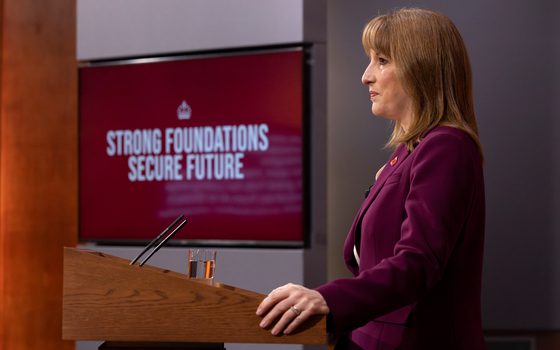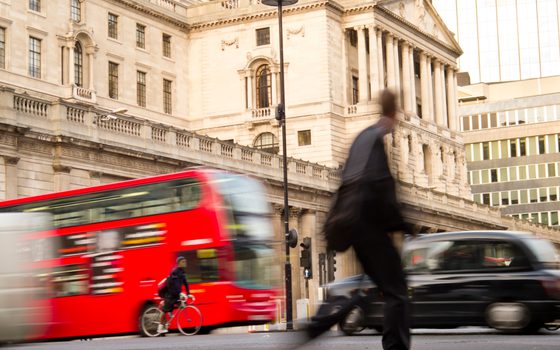A new “green interest rate” is needed if the UK is to meet its net zero ambitions.
Lower interest rates for green investments could save businesses and households £6.2bn on interest payments over the next four years.
01 November 2023
The Bank of England should introduce a lower “green interest rate” for net-zero investments as the UK enters an age of climate finance instability, according to new analysis from the New Economics Foundation.
The costs of financing the transition to net zero have risen significantly as the Bank of England has raised interest rates. The collapse of the recent bidding round for offshore wind licenses shows this is already impacting the UK’s ability to fund renewable energy infrastructure.
However, new analysis by the New Economics Foundation argues that a lower interest rate for green investments could help us hit our net-zero targets.
The lower rate for green projects would save businesses and households £6.2bn in financing costs over the next four years, the analysis shows.
Under the terms of the new Green Term Funding Scheme, the Bank of England would lend money to banks for them to finance green investments at a lower interest rate. This would make it cheaper for businesses and individuals to borrow money for green investments.
Investing in renewable energy and home insulation would also bring down energy bills, reducing inflation in the medium term and making the UK less susceptible to price shocks.
Theo Harris, Assistant Researcher at the New Economics Foundation, said:
“High interest rates are already harming net zero investments. Just weeks ago, the government’s offshore wind license bidding round collapsed because the finances didn’t stack up for private sector bidders.
“The extraordinary inflation we’ve seen recently was largely caused by global gas prices. If we want to avoid future shocks like this, we need to rapidly reduce our reliance on fossil fuels. But high interest rates discourage net zero investments. The Bank of England is shooting itself in the foot: the attempt to control immediate inflation is probably worsening medium to long term inflation. A dual rates approach is a solution to this dilemma.
“The costs of inaction on climate will far surpass the costs of action, so we must act soon. If adopted, our proposal for a green interest rate could save businesses and households £6.2 billion in financing costs over the next four years and bring a swathe of climate capital projects back online.
“We are not alone in advocating this approach, China and Japan have adopted similar measures already. The idea also has the backing of a key member of the Bank of England’s Monetary Policy Committee. It’s an idea that is increasingly looking like common sense.”
It’s projected that UK businesses will need to spend £54bn a year to reduce emissions with £27bn of that needing to be financed by loans. NEF’s analysis shows that £6.2bn could be saved over four years if financed at a lower green interest rate, which would allow for more green investments.
If well targeted and constructed, a green interest rate would help to tackle the cost of living and support the Bank of England in delivering its primary mandate of price stability as well as its secondary mandate of supporting government economic policy, including the net zero transition.
The proposal would speed up our transition away from fossil fuels through reducing the financing costs of renewable energy projects. This means cheaper renewable electricity and less vulnerability to future energy price shocks.
Notes to Editors
The New Economics Foundation is a charitable think tank. We are wholly independent of political parties and committed to being transparent about how we are funded.
The full analysis can be found here: https://neweconomics.org/2023/11/its-time-for-interest-rates-to-go-green
The analysis derives from the Balanced Investment Pathway laid out in the Climate Change Committee’s Sixth Carbon Budget (December 2020). This gives a figure for the total additional investment needed each year for the UK to reach its climate targets.
The OBR’s Fiscal Risks Report (July 2021) Central Scenario gives an estimated proportion of this investment that will come from private sources (businesses and households), and we drew on IEA analysis to estimate how much of this private investment would be financed by debt (rather than equity/savings).
Following the methodology of the CCC’s Finance Advisory Group, we assume a 7.5‑year repayment period for loans.
By modelling the historic relationship between Bank Rate and effective interest rates for households and businesses, we could then calculate the hypothetical interest payments on this debt in the period 2024 – 7 under two scenarios: a) Under forecast Bank Rate in a business-as-usual scenario; b) under a green Term Funding Scheme calibrated to bring interest rates for green loans back down to pre-covid levels. The difference in interest payments between the two scenarios is £6.2bn.
Topics Banking & finance Climate change






